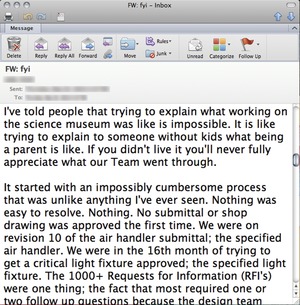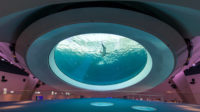
After enduring eight months of stalled construction and recently rejecting Suffolk Construction's latest claim for cost and schedule adjustments, the owner of a Miami science museum project terminated the construction manager "for convenience" and hired Skanska USA to finish the $275-million contract. Museum officials contend that Skanska—which took over the job on May 16—can complete construction by the end of 2015, or about eight months ahead of what they claim was Suffolk's completion target, August 2016.
Neither the contractor nor the owner will discuss details of Suffolk's last claim, which was submitted in February. The owner had announced its rejection in April. But, according to public records and to Suffolk documents, the timing coincides with deteriorating relations between the parties.
According to a summary of the April status report to Miami-Dade County, museum officials rejected the claim "for delay" because "it did not conform to the requirements of the contract." The report says "Suffolk has failed to produce a schedule as per the contract and previously indicated that they will not produce such a schedule until June." Suffolk denies the assertions, contending it updated project schedules monthly, with the owner approving them. Executive Vice President Jeffrey Gouveia says the firm's "April 11 schedule submission showed Suffolk recovering the time caused by owner delays and completing by December 2015." Nevertheless, on May 16, the museum named Skanska as CM.
Reacting to what Suffolk claims is its first-ever termination, firm officials say the job was plagued by design issues. "Design was uncoordinated between the disciplines," Gouveia says. For instance, illustrations of 4-ft-dia penetrations to exterior concrete walls were missing entirely from structural plans, he says.
An internal company email by Chris Kennedy, a Suffolk vice president who worked on site, forwarded to ENR, alleges that the eight-month shutdown in 2013 occurred because "the design was so uncoordinated that we literally could not pour concrete without fear of having to tear it out when design was finally coordinated."
Kennedy's May 16 email adds that "things went from bad to worse" after the firm submitted its February claim for a "time extension with associated costs." It also states that "Suffolk now became the cause of the past delays in the eyes of the owner. For the past three months we have lived under the threat of termination with a constant barrage of threatening and disparaging letters." Asked about these issues, design architect Grimshaw and architect-of-record Rodriguez & Quiroga referred ENR to museum officials, who declined comment.
In an emailed response to ENR, museum Chief Operating Officer Frank Steslow states that construction should be completed by the end of 2015. "With Skanska, we are evaluating the schedule and any impact over the next 90 days, although we don't currently expect any significant changes in the timeline," he said, adding that "there is no change" to the $275-million construction budget.
Museum officials chose Skanska due to the firm's familiarity with the project, since it was a runner-up to Suffolk during the initial request for qualifications, saysSteslow. "We felt they were well positioned to take over as project manager," he adds. The status report to the county adds that the museum "has developed a comprehensive plan to ensure the construction of the building continues with minimal interruption."
Contractors began work on the five-story, 250,000-sq-ft museum in March 2012. Plans include a 35,000-sq-ft, 600,000-gallon aquarium viewable from indoor or outdoor locations, a 200-seat 3D planetarium and 55,000 sq ft of indoor and outdoor exhibits.
According to information previously provided by Suffolk, the project is intended to achieve a minimum of LEED Gold certification. Plans call for harnessing energy from water, sun, wind and even movements of museum visitors.




Post a comment to this article
Report Abusive Comment